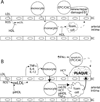Accelerated atherosclerosis in patients with SLE--mechanisms and management
- PMID: 22331061
- PMCID: PMC3765069
- DOI: 10.1038/nrrheum.2012.14
Accelerated atherosclerosis in patients with SLE--mechanisms and management
Abstract
Rapid-onset cardiovascular disease (CVD) is a major concern for many patients with systemic lupus erythematosus (SLE). Cardiovascular events occur more frequently and with earlier onset in patients with SLE compared with healthy individuals. Traditional risk factors, such as altered lipid levels, aging and smoking, do not fully explain this increased risk of CVD, strongly suggesting that autoimmunity contributes to accelerated atherosclerosis. Altered immune system function is recognized as the primary contributor to both the initiation and progression of atherosclerosis. Multiple manifestations of autoimmunity, including changes in cytokine levels and innate immune responses, autoantibodies, adipokines, dysfunctional lipids, and oxidative stress, could heighten atherosclerotic risk. In addition, multiple SLE therapeutics seem to affect the development and progression of atherosclerosis both positively and negatively. SLE-specific cardiovascular risk factors are beginning to be discovered by several groups, and development of a comprehensive, clinically feasible biomarker panel could be invaluable for identification and treatment of patients at risk of developing accelerated atherosclerosis. Here, we discuss the epidemiology of CVD in SLE and the implications of immune system dysfunction on the development and progression, monitoring and treatment of atherosclerosis in individuals with this disease.
Figures

References
-
- Libby P. Inflammation in atherosclerosis. Nature. 2002;420:868–874. - PubMed
-
- Urowitz MB, et al. The bimodal mortality pattern of systemic lupus erythematosus. Am J Med. 1976;60:221–225. - PubMed
-
- Nossent J, et al. Current causes of death in systemic lupus erythematosus in Europe, 2000--2004: relation to disease activity and damage accrual. Lupus. 2007;16:309–317. - PubMed
-
- Esdaile JM, et al. Traditional Framingham risk factors fail to fully account for accelerated atherosclerosis in systemic lupus erythematosus. Arthritis Rheum. 2001;44:2331–2337. - PubMed
-
- Manzi S, et al. Age-specific incidence rates of myocardial infarction and angina in women with systemic lupus erythematosus: comparison with the Framingham Study. Am J Epidemiol. 1997;145:408–415. - PubMed
Publication types
MeSH terms
Grants and funding
LinkOut - more resources
Full Text Sources
Medical

